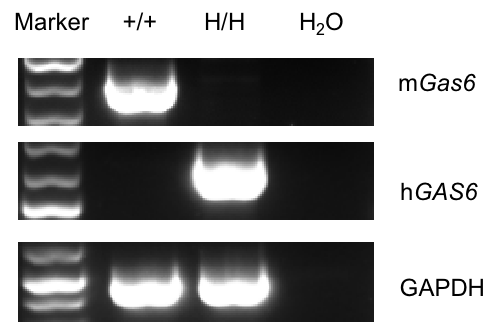|
Strain Name
|
C57BL/6-Gas6tm1(GAS6)Bcgen/Bcgen
|
Common Name
|
B-hGAS6 mice
|
|
Background
|
C57BL/6
|
Catalog number
|
110985
|
Related Genes
|
Gas6 (AXSF; AXLLG)
|
NCBI Gene ID
|
14456
|
Model description
Gas6 (growth arrest specific 6) encodes a gamma-carboxyglutamic acid (Gla)-containing protein thought to be involved in the stimulation of cell proliferation. This gene is frequently overexpressed in many cancers and has been implicated as an adverse prognostic marker. Elevated protein levels are additionally associated with a variety of disease states, including venous thromboembolic disease, systemic lupus erythematosus, chronic renal failure, and preeclampsia. The functions of Gas6 are limited to TAM receptor activation. When activated, the TAM receptors like AXL have effects on primary hemostasis and coagulation and display an anti-inflammatory or a proinflammatory effect, depending on cell type. The Gas6/Axl signaling pathway has been implicated in the promotion of tumor cell proliferation, survival, migration, invasion, angiogenesis, and immune evasion, and are involved in several biological functions and participate in the development and progression of a range of malignancies and autoimmune disorders1. In the tumor microenvironment, cancer-associated fibroblasts (CAFs) and CD45+-expressing tumor-infiltrating leukocytes (TILs) also express Gas6. Among the TILs, macrophages and dendritic cells express high levels of Gas6, Given that Gas6 and Axl are expressed on both neoplastic and host cells, targeting this pathway presents a novel strategy to impair multiple stages of cancer development, progression, and metastasis. A number of Axl inhibitors have been developed and studied in preclinical and clinical settings for various cancer types2.
mRNA expression analysis
Strain specific analysis of GAS6 gene expression in wild-type C57BL/6 mice and B-hGAS6 mice by RT-PCR. Mouse Gas6 mRNA was detectable only in ovary of wild-type C57BL/6 mice (+/+). Human GAS6 mRNA was detectable only in homozygous B-hGAS6 mice (H/H), but not in wild-type mice.
Protein expression analysis
Strain specific GAS6 expression analysis in homozygous B-hGAS6 mice by ELISA. Plasma was collected from wild-type mice (+/+) and homozygous B-hGAS6 mice (H/H), and analyzed by ELISA with species-specific GAS6 ELISA kit. Mouse GAS6 was detectable only in wild-type mice. Human GAS6 was exclusively detectable in homozygous B-hGAS6 mice but not in wild-type mice.
Analysis of leukocytes cell subpopulation in spleen

Analysis of spleen leukocyte subpopulations by FACS. Splenocytes were isolated from female C57BL/6 and B-hGAS6 mice (n=3, 6-week-old). Flow cytometry analysis of the splenocytes was performed to assess leukocyte subpopulations. A. Representative FACS plots. Single live cells were gated for the CD45+ population and used for further analysis as indicated here. B. Results of FACS analysis. Percent of T/B cells, NK cells, dendritic cells, granulocytes, monocytes and macrophages in homozygous B-hGAS6 mice were similar to those in the C57BL/6 mice, demonstrating that GAS6 humanized does not change the overall development, differentiation or distribution of these cell types in spleen. Values are expressed as mean ± SEM.
Analysis of T cell subpopulation in spleen
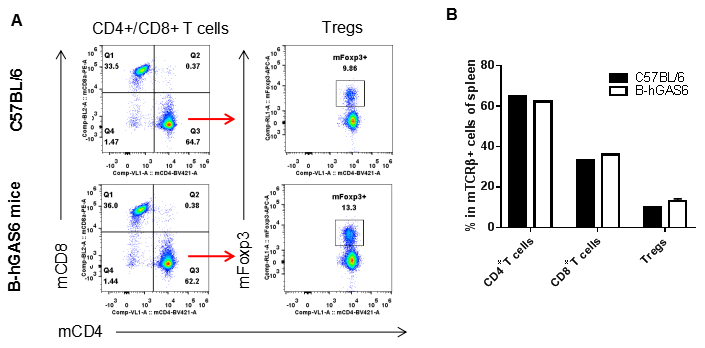
Analysis of spleen T cell subpopulations by FACS. Splenocytes were isolated from female C57BL/6 and B-hGAS6 mice (n=3, 6-week-old). Flow cytometry analysis of the splenocytes was performed to assess leukocyte subpopulations. A. Representative FACS plots. Single live CD45+ cells were gated for TCRβ+T cell population and used for further analysis as indicated here. B. Results of FACS analysis. The percent of CD8+ T cells and CD4+ T cells in homozygous B-GAS6 mice were similar to those in the C57BL/6 mice, demonstrating that introduction of hGAS6 in place of its mouse counterpart does not change the overall development, differentiation or distribution of these T cell subtypes in spleen. Values are expressed as mean ± SEM.
Analysis of leukocytes cell subpopulation in lymph node
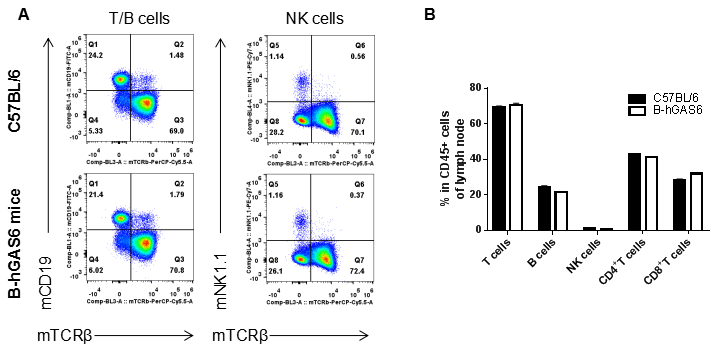
Analysis of lymph node leukocyte subpopulations by FACS. Leukocytes were isolated from female C57BL/6 and B-hGAS6 mice (n=3, 6-week-old). Flow cytometry analysis of the leukocytes was performed to assess leukocyte subpopulations. A. Representative FACS plots. Single live cells were gated for CD45+ population and used for further analysis as indicated here. B. Results of FACS analysis Percent of T cells, B cells, NK cells, in homozygous B-hGAS6 mice were similar to those in the C57BL/6 mice, demonstrating that introduction of hGAS6 in place of its mouse counterpart does not change the overall development, differentiation or distribution of these cell types in lymph node. Values are expressed as mean ± SEM.
Analysis of T cell subpopulation lymph node
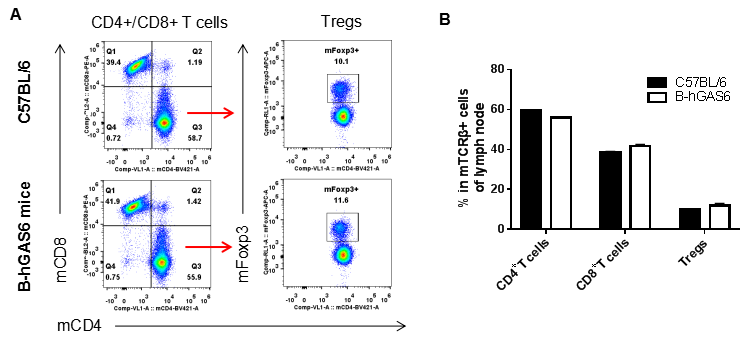
Analysis of lymph node leukocyte subpopulations by FACS. Leukocytes were isolated from female C57BL/6 and B-hGAS6 mice (n=3, 6-week-old). Flow cytometry analysis of the leukocytes was performed to assess leukocyte subpopulations. Representative FACS plots. Single live CD45+ cells were gated for TCRβ+ T cell population and used for further analysis as indicated here. B. Results of FACS analysis. The percent of CD8+ T cells, CD4+ T cells and Treg cells in homozygous B-hGAS6 mice were similar to those in the C57BL/6 mice, demonstrating that introduction of hGAS6 in place of its mouse counterpart does not change the overall development, differentiation or distribution of these cell types in lymph node. Values are expressed as mean ± SEM.
Analysis of leukocytes cell subpopulation in blood

Analysis of blood leukocyte subpopulations by FACS. Blood were isolated from female C57BL/6 and B-hGAS6 mice (n=3, 6-week-old). Flow cytometry analysis of the leukocytes was performed to assess leukocyte subpopulations. A. Representative FACS plots. Single live cells were gated for CD45+ population and used for further analysis as indicated here. B. Results of FACS analysis Percent of T cells, B cells, NK cells, dendritic cells, granulocytes, monocytes and macrophages in homozygous B-hGAS6 mice were similar to those in the C57BL/6 mice, demonstrating that introduction of hGAS6 in place of its mouse counterpart does not change the overall development, differentiation or distribution of these cell types in blood. Values are expressed as mean ± SEM.
Analysis of T cell subpopulation in blood
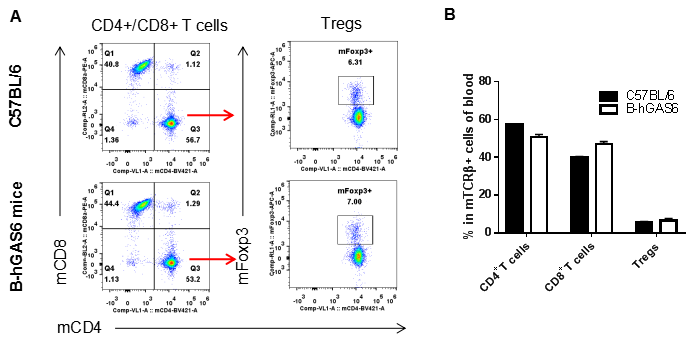
Analysis of blood leukocyte subpopulations by FACS. Blood were isolated from female C57BL/6 and B-hGAS6 mice (n=3, 6-week-old). Flow cytometry analysis of the leukocytes was performed to assess leukocyte subpopulations. Representative FACS plots. Single live CD45+ cells were gated for TCRβ+ T cell population and used for further analysis as indicated here. B. Results of FACS analysis. The percent of CD4+, CD8+, Treg cells in homozygous B-hGAS6 mice were similar to those in the C57BL/6 mice, demonstrating that introduction of hGAS6 in place of its mouse counterpart does not change the overall development, differentiation or distribution of these cell types in blood. Values are expressed as mean ± SEM.
